Artemis: The return to the Moon that will set new space records
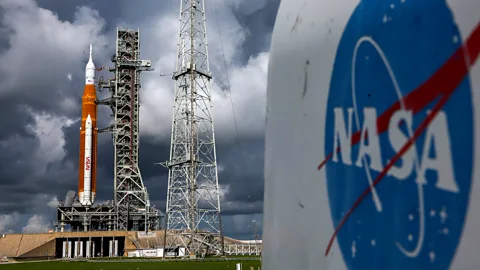 Kevin Dietsch/Getty Images
Kevin Dietsch/Getty ImagesThe Artemis space programme is preparing to return humanity to the lunar surface and beyond. How will it make history?
After an absence of 50 years, Nasa is returning to the Moon. This time the programme is named after Artemis, the Greek goddess of the Moon and twin sister of Sun god Apollo. Not only is it a better fit in terms of name and destination, Artemis will ensure something Apollo neglected to do: it will put the first woman on the Moon.
Appropriately, Nasa's first female launch director, Charlie Blackwell-Thompson, oversaw the countdown and lift-off of the first mission. But Artemis I was far more than a feminist moment. During its almost 26-day journey in an extended retrograde orbit around the Moon – travelling in the opposite direction to the Moon orbiting the Earth – it achieved the first of a number of other important firsts.
"We're going to take the first human vehicle further than any human vehicle has gone before," says Jim Free, Nasa's Associate Administrator for Exploration Systems Development. "And we're going to go 40,000 miles (64,000km) past the Moon with the Orion capsule."
Orion – Nasa's new crewed exploration spacecraft – flew 270,000 miles (434,500km) from the Earth during the Artemis I mission, far beyond the record set by the crew of Apollo 13 back in 1970. As Artemis I was a test flight, however, the Orion spacecraft's crew consisted of a human-sized mannequin wearing sensors to measure what stresses, strains and potential radiation will greet the (real) crew for Artemis II and beyond. The human crew of Artemis II will fly 6,400 miles (10,299km) beyond the dark side of the Moon, taking them around around 230,000 miles (370,150km) from Earth. They won't quite break the record of 248,655 miles (400,171km) set by the Apollo 13 crew. But there are many other new records the Artemis missions will set.
After several delays caused by technical glitches and hydrogen fuel leaks, Artemis I launched on 16 November 2022 on a Space Launch System (SLS) rocket which – although smaller than the Saturn V – has the tallest rocket stage in the world at 64.6m (212ft).
You might also like:
"The SLS is the most powerful rocket built," says Free. "It's 8.8 million pounds of thrust and, when we reach our peak flight rate, the Artemis programme will take four people down to the surface of the Moon for 30 days."
This is a considerable upgrade. Throughout all the Moon landings the longest time astronauts spent on the surface was just over three days, during Apollo 17 in 1972.
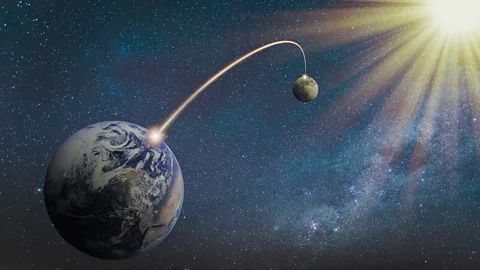 Buena Vista Images/Getty Images
Buena Vista Images/Getty ImagesThe focus for Artemis will also be different. Back in the 1960s, Apollo was primarily part of a Cold War power race between America and the Soviet Union. Artemis is an international effort led by Nasa including the Canadian Space Agency (CSA), the Japan Aerospace Exploration Agency (Jaxa) and the European Space Agency (Esa).
"This is not about flags and footprints," says Thomas Zurbuchen, Nasa's Associate Administrator for Science. "It's about building a sustainable presence on the Moon and to set in place the foundations for a moonbase and future missions to Mars."
Zurbuchen and Free were at Paris Airport when I spoke to them after attending the International Astronautical Congress. The theme for this year's event was "Space for @ll" with the aim of bringing together communities and forging new contacts and potential partnerships. Nasa's ambitious endeavour to the Moon and beyond does just that, involving space agencies, commercial companies and industries across the globe.
I witnessed an example of this international collaboration first hand in May 2022 at an inspection simulation of Artemis I. This pre-launch check exercise was performed simultaneously between teams at Nasa's Johnson Space Center in Houston, Texas in the US; the German Space Operations Centre at Esa's Columbus Control Centre in Oberphfaffenhofen; and – where I was located – Esa's technical site, Estec, at Noordwijk, the Netherlands.
The aim of the exercise was to identify, in real time, any potential anomalies before launch. Inside Estec's Erasmus Support Facility control room, I spotted a Nasa mug with a famous quote from the film Apollo 13. Due to an oxygen tank explosion, Apollo 13 never made it to the Moon but it did bring its crew safely home thanks to the ingenuity of engineers on the ground.
"Failure," the mug stated, "is not an option."
During simulations like this, however, failures are deliberately inserted into exercises to see how the team reacts and resolves any issues.
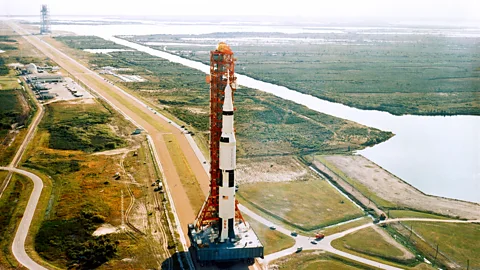 Universal Images Group/Getty Images
Universal Images Group/Getty Images"You shake out all the bugs and then you fly," says Kevin Pasay, Esa's Erasmus Support Facility manager. "Being the first machine to be human rated from Nasa in a long time, they are being very astute making sure any little anomalies are checked out. So we've been through four dress rehearsals already. We're repeating simulations to keep people fresh."
Esa has provided a crucial part of the Artemis mission: the European Service Module. Attached to the Orion capsule, it provides power, propulsion and, when astronauts are on board, life support. "This team will take care of those who will be going to the Moon and beyond," says Pasay.
It's clear from this exercise alone that returning to the Moon with Artemis is not one nation's effort. The focus is also no longer political.
"Scientific exploration is very much at centre of the entire strategy. In Apollo, science was the icing on the cake," says Nasa's Zurbuchen. "Science is the cake on Artemis."
During its mission, aside from tests for future spaceflights, Artemis I released 10 small scientific satellites or cubesats. One, BioSentinel, is the size of a shoebox and will be the first long-duration biology experiment in deep space.
BioSentinel contains yeast because the cells of these micro-organisms have similar mechanisms to human cells and will allow further study into how deep space radiation affects DNA. This will provide a better understanding of the risks astronauts might encounter in the same environment.
"These biological experiments set a record of extending life from Earth into deep space behind the Moon," says Zurbuchen.
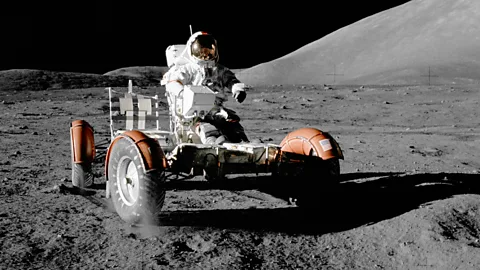 Nasa/Getty Images
Nasa/Getty ImagesThere are also two mannequin torsos, one wearing a prototype radiation protection vest, for an experiment by the Israel Space Agency (Isa) and the German Aerospace Center (DLR).
On its return to Earth, Artemis I also tested the Orion spacecraft's heat shield to ensure it can withstand temperatures up to 2,760C (5000F) on re-entry – vital for protecting the four astronauts who will be on board Artemis II when it launches in May 2024.
Artemis II will orbit but not land on the Moon. That historic moment will be made by Artemis III, which will also place the first astronaut from an ethnic minority onto the lunar surface.
"That's really important," says Nasa's Zurbuchen, who grew up in Switzerland before moving to the US. "If you look at all the Apollo pictures, it's clear that everybody kind of looks like me, with a black tie, and that basically means that the majority of the world is excluded from that experience." The team of astronauts selected for Artemis are far more diverse than those who flew on Apollo.
The landing sites for Artemis will also present something new. "More challenging," Zurbuchen says, "and much more interesting."
"Apollo went to the equatorial regions of the Moon," says Free. "Artemis is going to go to the South Pole, where we will look for the resources that we've seen by observations from scientific spacecraft. We believe there's a great deal of water ice there which, of course, we can use to maintain the crew and even use water to separate into hydrogen and oxygen to create fuel and power."
The Orion spacecraft may resemble a larger version of Apollo but its technology is on another level. According to Nasa, Orion's computer operates 20,000 times faster with 128,000 times more memory than those used on the Apollo missions.
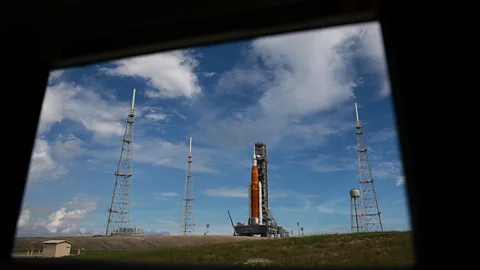 Joe Raedle/Getty Images
Joe Raedle/Getty ImagesArtemis I even tested out the equivalent of Alexa and Siri voice assistants. Developed by Lockheed Martin with Cisco and Amazon, the Callisto system is designed to allow voice-activated commands and feedback during future missions. Just don't mention Hal, the infamous computer from Arthur C Clarke's 2001: A Space Odyssey.
It's clear that Artemis is far more than an Apollo rerun. Nasa, together with Jaxa, CSA, Esa and commercial partnerships, will also establish the Gateway, a small space station orbiting the Moon in deep space to facilitate further lunar excursions and an eventual base. Nasa is even hoping to install the first lunar communications network – called LunaNet – that will bring internet-like services to the Moon, along with navigational capabilities.
Around 650 million people watched the first man walk on the Moon. Who knows, with the addition of social media and smartphones, how many worldwide will watch the first woman or non-white astronaut take that next "one small step" with Artemis III.
"I love space exploration. I think it's inspirational and aspirational. It took me into a technical field and I hope it does that for others," says Free, who began his career at Nasa as a propulsion engineer. "We're exploring again, we're exploring the Moon and we're exploring together."
* This article was originally published on 16 November 2022. It was updated on 19 May 2023 to include details since Artemis I's launch.
--
